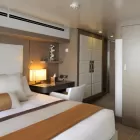Located on the island of Honshu, hugging the banks of the Sento Inland Sea, Tamano is a popular destination thanks to its sun-drenched climate. Upon arrival, marvel at the way in which the city has been built along the coast at the foot of a deep, dark forest. In the area surrounding Tamano, stroll down the streets of Kurashiki, known as the 'white-walled city' in a nod to the pretty façades of the houses that line the streets of this ancient Edo-period trading town. Another major regional attraction is the Seto Ohashi bridge. Its 12.5 kilometres make it the world's longest double-decker bridge.
Optional Excursions:
HIGHLIGHTS OF OKAYAMA
Okayama is the capital of Okayama Prefecture, and the largest city in the Chugoku Region after Hiroshima. The city developed as a castle town during the Edo Period (1603-1867) and became a significant regional power.
From the pier, embark your coach for the one-hour drive to the Bizen Osafune Samurai sword Museum. This is one of the few sword museums which features a variety of Japanese Samurai swords on display. Learn about the history and manufacturing process for Japanese swords as well as experience the beauty and power of the swords up close. At the workshop, see how the craftsmen are maintaining the traditional skills of sword manufacturing.
Continue with a visit to the Korakuen garden, which is one of the three best landscape gardens in Japan along with Kairakuen Garden in Mito and Kenrokuen Garden in Kanazawa. With an area of 133,000 sqm, the garden was built in 1700 by the local feudal lord Ikeda Tsunamasa in the Enshu landscape style of stroll garden. The garden houses a tea-ceremony house, several ponds, a small waterfall and elegantly designed landscapes. As the seasons change, pine trees, maples, cherry and plum trees reach their peak of beauty.
HISTORICAL KURASHIKI
Located in the western part of Okayama Prefecture, Kurashiki is a historic city, developed as a port town along the Kurashiki River. It is also called the "white-wall town", for its lovely houses with white walls and black tile roofs.
From the pier, embark your coach for the one-hour drive to the Kurashiki Bikan historical area. This district along the Kurashiki River has preserved the atmosphere of the Edo Period, and still contains old storehouses that were a vital location in the distribution of goods throughout Japan at that time. The area includes numerous museums and sightseeing spots. All electrical wires are buried beneath the ground so there is nothing to mar the view of the buildings. Many of the buildings you can see were originally rice granaries built in the late 18th century. The tiled roofs, white-washed walls, black-tiled walls with lattice windows were the characteristics of Kurashiki.
Next, walk to the Ohashi family old merchant house, this 200-year-old merchant's house was appointed as an Important Cultural Property in 1978. The Ohashi family built their wealth on salt farming and financial business in the Edo period (1603-1867). The main wing is simple and solid, designed with fire-resistance architecture. A gate terrace, that was privileged to the high-class family, demonstrates their outstanding prosperity in the area.
From the variety of museums, you will visit the Kurashiki museum of folk craft, which exhibits more than 10,000 items collected by Mr. Kichinosuke Tonomura, the first President of this museum. His collection includes the whole range of practical goods for everyday use, such as ceramics, textiles, lacquers, baskets, wood

























